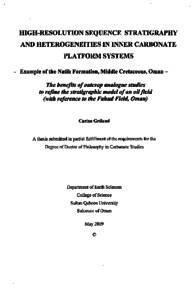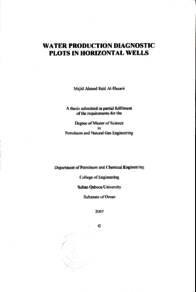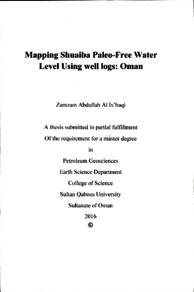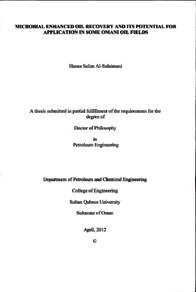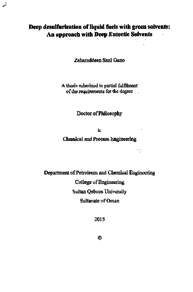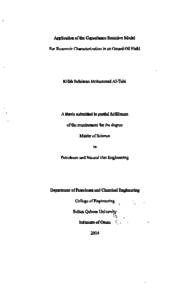Document
Iron based scale in a sour oil field : sources identification, simulation, treatment and prevention
Publisher
Sultan Qaboos University
Gregorian
2015
Language
English
Subject
English abstract
Iron based scale has been observed in deep sour oil production wells in south of Oman. The wells are fracture stimulated to achieve economic oil production from a thick, tight, silicilyte formation. The scale builds up at varying depths resulting in limited access through tubing, reduced productivity and, in worst cases, well abandonment and re-drill. Those wells produce light oil which exhibits high H2S and CO2 content in the associated gas and, except for early unloading of fracture fluids, produces water-free oil throughout their life. Reservoir formation water is initially considered immobile, therefore, the current theory is only fracture fluid, which can be up to 4000 m', provides an environment for scale deposition, possibly after mixing with formation water increasing water saturation in the immediate vicinity of a wellbore and its hydraulic fractures.
This study discusses the mechanism of scale deposition and scale sources identification through modeling and isotope tests. Also, suitable scale clean out fluids and methodologies has been identified based on lab experiments.
Most of the scales are identified as Fe-bearing such as iron sulfides. Possible sources of iron are: proppant, cement, reservoir rock and downhole well completion. Simulation work using MoReS-PHREEQC was conducted as part of the study to forecast the types and amount of iron based scale precipitation that can be anticipated at varying reservoir and producing conditions. Preliminary results indicate that all mechanisms and different scale types precipitate in the wellbore and sand face. The iron in the scale might be from the reservoir formation or from hematite in the cement or proppants; identified using isotope tests. However, simulation results conclude that the main source of iron is completion corrosion. Although simulation results indicated that other iron sources (formation, hematite in cement and proppant) contribute to scale deposition, it does so at a limited rate.
Laboratory tests were conducted using hydrochloric acid at different ratio and concentration and four other dissolution fluids to dissolve iron sulfide scale. The influences of various acid additives on the dissolution power of the acid and the corrosion of oilfield steels were examined. Iron sulfide scale is soluble in hydrochloric acid. More iron sulfide scale can be dissolved by using high acid concentrations rather than using large amounts of solutions that contain low acid concentrations. Considering the volumes of the solvents (provided by service company) and the time of reactions, using acid results in better solubility.
Scales clean out methodologies were identified and a scale mitigation plan for existing and new wells is proposed. The study also evaluated the most cost effective and feasible ways to remove different types of scale deposits. The future scale prevention and removal strategies to be implemented in existing and future wells are being derived in large part from the results of the work described in this study.
Arabic abstract
يتم إنتاج النفط الحمضي من أحد المكامن العميقة عالية الضغط في جنوب سلطنة عمان. و صخور هذا المكمن ذات نفاذية شحيحة مما يستدعي الحاجة إلى تصديع هذه الصخور بالضغط العالي لتحفيز الإنتاج والحصول على عائد اقتصادي مجدي. و تنتج آبار هذا المكمن نفطا خفيفا مصحوبا بغازات حمضية سامة مثل حمض كبريتيد الهيدروجين وثاني أكسيد الكربون. و بحسب المعلومات المتوفرة لا يتوقع إنتاج ماء مصاحب للنفط و يعتقد أن مصدر الكمية القليلة من الماء المنتجة هي من عملية تصديع الصخور بالضغط العالي. إلا أنه لوحظ وجود ترسبات تحتوي على نسبة عالية من الحديد في الأنابيب الموجودة بابار الإنتاج مما يعيق إدخال الأجهزة و الأدوات داخل البئر لجمع المعلومات و البيانات اللازمة لفهم المكمن أو لإغلاق البئر عند حدوث أي خلل. وقد تعمل هذه الترسبات في أسوء الظروف على تقليل الإنتاج عند ترسبها في الشقوق والتصدعات حول البئر.
و تناقش هذه الدراسة آلية تكون هذه الترسبات و مصادرها و ذلك عن طريق استخدام برنامج المحاكاة و اختبار النظائر. كما تم عمل تجارب مخبرية بهدف تحديد المذيبات المناسبة لهذه الترسبات و ذلك لتنظيف آبار الإنتاج.
وقد خلصت الدراسة إلى أن المكون الأساسي لهذه الترسبات هو مركبات الحديد مثل كبريتيد الحديد و كربونات الحديد. و من الممكن أن يكون مصدر هذه الترسبات هو الرمل الصناعي المستخدم في عملية تصديع الصخور أو إضافات الإسمنت المستخدم في تثبيت الأنابيب المبطنة للبئر أو من صخور المكمن أو أنابيب الإنتاج داخل البئر. و تم استخدام برنامج المحاكاة ( MoReS - PHREEQC ) لفهم مصادر و ألية تكون هذه الترسبات و أماكن ترسبها و قد أشارت النتائج الأولية إلى تكون هذه الترسبات داخل أنابيب الإنتاج في البئر و في الشقوق الناتجة من تصديع الصخور و يشير اختبار النظائر إلى أن مصدر الحديد قد يكون من كل المصادر المذكور أعلاه وذلك ما أكده برنامج المحاكاة. وقد أوضح برنامج المحاكاة أن تلك المصادر تساهم بنسب مختلفة في كمية الحديد في تلك الترسبات و أن المصدر الرئيسي هو صدأ أنابيب الإنتاج الموجودة في البئر.
ومن المعلوم كيميائيا أن مركبات الحديد تذوب في حمض الهيدروكلوريك. وهذا ما أكدته عدة تجارب باستخدام هذا الحمض كمذيب بنسب وتراكيز متفاوتة. وقد تم اختبار تأثير بعض الإضافات الضرورية للحمض على قدرته على التفاعل. كما تم اختبار تأثير الحمض على صدء أنابيب الإنتاج. كما تضمنت التجارب استخدام اربعة مذيبات مختلفة من إحدى الشركات المتخصصة . وقد أظهرت تلك التجارب أنه من الممكن إذابة كمية أكبر من الترسبات باستخدام كمية قليلة ذات تركيز عالي من الحمض مقارنة باستخدام كمية كبيرة ذات تركيز منخفض. وتشير النتائج أن حمض الهيدروكلوريك أفضل من المذيبات الأخرى في إذابة الترسبات عند الأخذ بعين الإعتبار مدة التفاعل و كمية المذيب المستخدم في التفاعل.
كما ناقشت الدراسة طرق إزالة الترسبات ومنع أو تقليل حدوثها في الأبار القديمة و الحديثة . كما أوصت الدراسة باستخدام بعض الطرق ذات الكفاءة العالية وبأسعار منافسة مقارنة بالطرق التقليدية .
و تناقش هذه الدراسة آلية تكون هذه الترسبات و مصادرها و ذلك عن طريق استخدام برنامج المحاكاة و اختبار النظائر. كما تم عمل تجارب مخبرية بهدف تحديد المذيبات المناسبة لهذه الترسبات و ذلك لتنظيف آبار الإنتاج.
وقد خلصت الدراسة إلى أن المكون الأساسي لهذه الترسبات هو مركبات الحديد مثل كبريتيد الحديد و كربونات الحديد. و من الممكن أن يكون مصدر هذه الترسبات هو الرمل الصناعي المستخدم في عملية تصديع الصخور أو إضافات الإسمنت المستخدم في تثبيت الأنابيب المبطنة للبئر أو من صخور المكمن أو أنابيب الإنتاج داخل البئر. و تم استخدام برنامج المحاكاة ( MoReS - PHREEQC ) لفهم مصادر و ألية تكون هذه الترسبات و أماكن ترسبها و قد أشارت النتائج الأولية إلى تكون هذه الترسبات داخل أنابيب الإنتاج في البئر و في الشقوق الناتجة من تصديع الصخور و يشير اختبار النظائر إلى أن مصدر الحديد قد يكون من كل المصادر المذكور أعلاه وذلك ما أكده برنامج المحاكاة. وقد أوضح برنامج المحاكاة أن تلك المصادر تساهم بنسب مختلفة في كمية الحديد في تلك الترسبات و أن المصدر الرئيسي هو صدأ أنابيب الإنتاج الموجودة في البئر.
ومن المعلوم كيميائيا أن مركبات الحديد تذوب في حمض الهيدروكلوريك. وهذا ما أكدته عدة تجارب باستخدام هذا الحمض كمذيب بنسب وتراكيز متفاوتة. وقد تم اختبار تأثير بعض الإضافات الضرورية للحمض على قدرته على التفاعل. كما تم اختبار تأثير الحمض على صدء أنابيب الإنتاج. كما تضمنت التجارب استخدام اربعة مذيبات مختلفة من إحدى الشركات المتخصصة . وقد أظهرت تلك التجارب أنه من الممكن إذابة كمية أكبر من الترسبات باستخدام كمية قليلة ذات تركيز عالي من الحمض مقارنة باستخدام كمية كبيرة ذات تركيز منخفض. وتشير النتائج أن حمض الهيدروكلوريك أفضل من المذيبات الأخرى في إذابة الترسبات عند الأخذ بعين الإعتبار مدة التفاعل و كمية المذيب المستخدم في التفاعل.
كما ناقشت الدراسة طرق إزالة الترسبات ومنع أو تقليل حدوثها في الأبار القديمة و الحديثة . كما أوصت الدراسة باستخدام بعض الطرق ذات الكفاءة العالية وبأسعار منافسة مقارنة بالطرق التقليدية .
Member of
Resource URL
Same Subject
